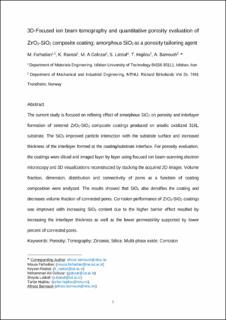| dc.contributor.author | Farhadian, M. | |
| dc.contributor.author | Raeissi, K. | |
| dc.contributor.author | Golozar, M.A. | |
| dc.contributor.author | Labbaf, S. | |
| dc.contributor.author | Hajilou, Tarlan | |
| dc.contributor.author | Barnoush, Afrooz | |
| dc.date.accessioned | 2021-04-06T09:33:24Z | |
| dc.date.available | 2021-04-06T09:33:24Z | |
| dc.date.created | 2020-10-12T13:23:34Z | |
| dc.date.issued | 2020 | |
| dc.identifier.citation | Applied Surface Science. 2020, 511 1-12. | en_US |
| dc.identifier.issn | 0169-4332 | |
| dc.identifier.uri | https://hdl.handle.net/11250/2736323 | |
| dc.description.abstract | The current study is focused on refining effect of amorphous SiO2 on porosity and interlayer formation of sintered ZrO2-SiO2 composite coatings produced on anodic oxidized 316L substrate. The SiO2 improved particle interaction with the substrate surface and increased thickness of the interlayer formed at the coating/substrate interface. For porosity evaluation, the coatings were sliced and imaged layer by layer using focused ion beam-scanning electron microscopy and 3D visualizations reconstructed by stacking the acquired 2D images. Volume fraction, dimension, distribution and connectivity of pores as a function of coating composition were analyzed. The results showed that SiO2 also densifies the coating and decreases volume fraction of connected pores. Corrosion performance of ZrO2-SiO2 coatings was improved with increasing SiO2 content due to the higher barrier effect resulted by increasing the interlayer thickness as well as the lower permeability supported by lower percent of connected pores. | en_US |
| dc.language.iso | eng | en_US |
| dc.publisher | Elsevier | en_US |
| dc.relation.uri | https://doi.org/10.1016/j.apsusc.2020.145567 | |
| dc.rights | Attribution-NonCommercial-NoDerivatives 4.0 Internasjonal | * |
| dc.rights.uri | http://creativecommons.org/licenses/by-nc-nd/4.0/deed.no | * |
| dc.title | 3D-Focused ion beam tomography and quantitative porosity evaluation of ZrO2-SiO2 composite coating; amorphous SiO2 as a porosity tailoring agent | en_US |
| dc.type | Peer reviewed | en_US |
| dc.type | Journal article | en_US |
| dc.description.version | acceptedVersion | en_US |
| dc.source.pagenumber | 1-12 | en_US |
| dc.source.volume | 511 | en_US |
| dc.source.journal | Applied Surface Science | en_US |
| dc.identifier.doi | 10.1016/j.apsusc.2020.145567 | |
| dc.identifier.cristin | 1838871 | |
| dc.relation.project | Norges forskningsråd: 244068 | en_US |
| dc.relation.project | Norges forskningsråd: 245963 | en_US |
| dc.description.localcode | "© 2020. This is the authors’ accepted and refereed manuscript to the article. Locked until 30.1.2022 due to copyright restrictions. This manuscript version is made available under the CC-BY-NC-ND 4.0 license http://creativecommons.org/licenses/by-nc-nd/4.0/ " | en_US |
| cristin.ispublished | true | |
| cristin.fulltext | postprint | |
| cristin.qualitycode | 1 | |

